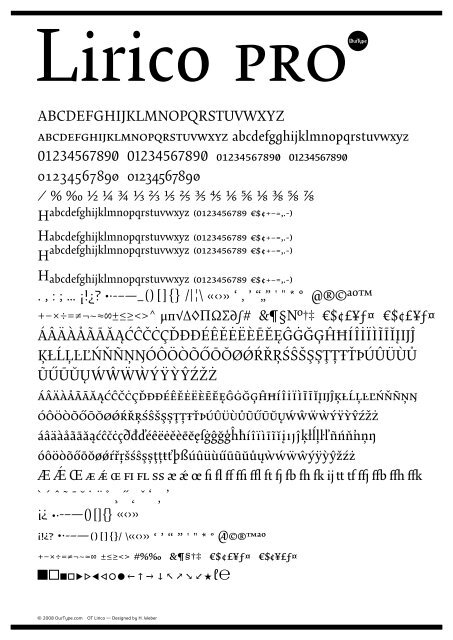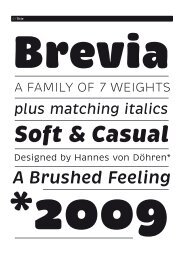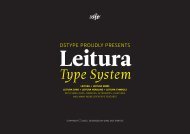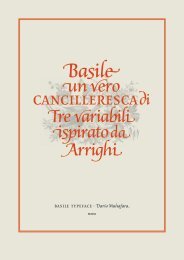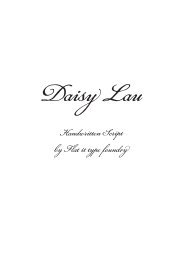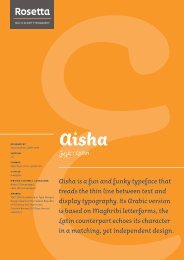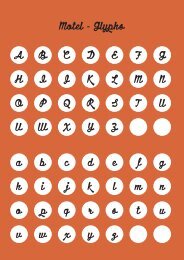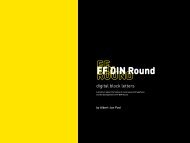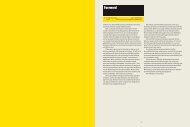Download Lirico Sample PDF - FontShop
Download Lirico Sample PDF - FontShop
Download Lirico Sample PDF - FontShop
Create successful ePaper yourself
Turn your PDF publications into a flip-book with our unique Google optimized e-Paper software.
<strong>Lirico</strong> pro<br />
Type design is done by specialists called type<br />
designers. At least, that’s what we may think<br />
at first. And it is true that there are many good<br />
typefaces made by ‘real’ type designers. But there<br />
are also many good typefaces made by people<br />
who mostly did other things, with some type<br />
designing on the side. By ‘type’ I mean indeed<br />
the letterforms used within typography, so I<br />
refer to the fonts which are used to compose<br />
text. This leaves out the area of handwriting,<br />
calligraphy, and lettering. Before the invention<br />
of graphic design, people who designed type<br />
might be engravers, writing masters, printers, or<br />
punchcutters. In the twentieth century many types were<br />
designed by people who had a strong relation to the printing<br />
industry but who were not type designers pure and simple.<br />
W. A. Dwiggins, for example, was a typographer and graphic<br />
designer who started to design type as well. Another example<br />
is the Dutch book typographer Bram de Does, who, after many<br />
years of working as a typographer, designed the typefaces<br />
trinité and lexicon. Both of these designers worked on<br />
typefaces that they themselves felt a need for, and these are<br />
often designs which excel in respect of drawing and character,<br />
within a certain style of letter. Another example would be<br />
syntax designed by Hans Eduard Meier. Here a personal need<br />
to create a humanist sanserif made all the difference. What is<br />
important in these examples is that the designers started on<br />
the task out of a strong personal impulse; nobody asked them<br />
to do so.<br />
Then there are the people who occupy themselves with type<br />
design and with nothing else. You will find them for sure in the<br />
world of the type-manufacturing companies: the employees working<br />
for Monotype, Adobe, or Linotype. In the factory – an office these<br />
days – people are asked to do type design or related activities<br />
for eight hours a day. They have to produce for the trade’s sake,<br />
and within such companies there is usually not much room for<br />
one’s own preferences and typographic needs. In addition to these<br />
opposite ends of the spectrum there are mixed cases. A company<br />
might ask a designer if he or she could provide them with a font.<br />
The request is often followed by some specifications from the<br />
customer; so ‘carte blanche’ is rare in such a case. And which<br />
category – the individual or the industry – is responsible for the best<br />
work? It is hard to answer; the question is also not specific enough<br />
Type design is done by specialists called type<br />
designers. At least, that’s what we may think<br />
at first. And it is true that there are many good<br />
typefaces made by ‘real’ type designers. But<br />
there are also many good typefaces made by people<br />
who mostly did other things, with some type<br />
designing on the side. By ‘type’ I mean indeed<br />
the letterforms used within typography, so I<br />
refer to the fonts which are used to compose<br />
text. This leaves out the area of handwriting,<br />
calligraphy, and lettering. Before the invention<br />
of graphic design, people who designed type<br />
might be engravers, writing masters, printers, or<br />
extralight & extralight italic 12/15 pt. & 9.2/12.5 pt. light & light italic 12/15 pt. & 9.2/12.5 pt.<br />
© 2008 OurType.com OT <strong>Lirico</strong> — Designed by H. Weber<br />
punchcutters. In the twentieth century many types were<br />
designed by people who had a strong relation to the printing<br />
industry but who were not type designers pure and simple.<br />
W. A. Dwiggins, for example, was a typographer and graphic<br />
designer who started to design type as well. Another example<br />
is the Dutch book typographer Bram de Does, who, after many<br />
years of working as a typographer, designed the typefaces<br />
trinité and lexicon. Both of these designers worked on<br />
typefaces that they themselves felt a need for, and these are<br />
often designs which excel in respect of drawing and character,<br />
within a certain style of letter. Another example would be<br />
syntax designed by Hans Eduard Meier. Here a personal need<br />
to create a humanist sanserif made all the difference. What is<br />
important in these examples is that the designers started on<br />
the task out of a strong personal impulse; nobody asked them<br />
to do so.<br />
Then there are the people who occupy themselves with type<br />
design and with nothing else. You will find them for sure in the<br />
world of the type-manufacturing companies: the employees working<br />
for Monotype, Adobe, or Linotype. In the factory – an office these<br />
days – people are asked to do type design or related activities<br />
for eight hours a day. They have to produce for the trade’s sake,<br />
and within such companies there is usually not much room for<br />
one’s own preferences and typographic needs. In addition to these<br />
opposite ends of the spectrum there are mixed cases. A company<br />
might ask a designer if he or she could provide them with a font.<br />
The request is often followed by some specifications from the<br />
customer; so ‘carte blanche’ is rare in such a case. And which<br />
category – the individual or the industry – is responsible for the<br />
best work? It is hard to answer; the question is also not specific
<strong>Lirico</strong> pro<br />
Type design is done by specialists called type<br />
designers. At least, that’s what we may think<br />
at first. And it is true that there are many good<br />
typefaces made by ‘real’ type designers. But<br />
there are also many good typefaces made by<br />
people who mostly did other things, with some<br />
type designing on the side. By ‘type’ I mean<br />
indeed the letterforms used within typography,<br />
so I refer to the fonts which are used to compose<br />
text. This leaves out the area of hand-<br />
writing, calligraphy, and lettering. Before the<br />
invention of graphic design, people who designed<br />
type might be engravers, writing masters,<br />
printers, or punchcutters. In the twentieth century many types<br />
were designed by people who had a strong relation to the<br />
printing industry but who were not type designers pure and<br />
simple. W. A. Dwiggins, for example, was a typographer and<br />
graphic designer who started to design type as well. Another<br />
example is the Dutch book typographer Bram de Does, who,<br />
after many years of working as a typographer, designed the<br />
typefaces trinité and lexicon. Both of these designers<br />
worked on typefaces that they themselves felt a need for, and<br />
these are often designs which excel in respect of drawing and<br />
character, within a certain style of letter. Another example<br />
would be syntax designed by Hans Eduard Meier. Here<br />
a personal need to create a humanist sanserif made all the<br />
difference. What is important in these examples is that the<br />
designers started on the task out of a strong personal impulse;<br />
nobody asked them to do so.<br />
Then there are the people who occupy themselves with type<br />
design and with nothing else. You will find them for sure in the<br />
world of the type-manufacturing companies: the employees working<br />
for Monotype, Adobe, or Linotype. In the factory – an office these<br />
days – people are asked to do type design or related activities for<br />
eight hours a day. They have to produce for the trade’s sake, and<br />
within such companies there is usually not much room for<br />
one’s own preferences and typographic needs. In addition to<br />
these opposite ends of the spectrum there are mixed cases. A<br />
company might ask a designer if he or she could provide them<br />
with a font. The request is often followed by some specifications<br />
from the customer; so ‘carte blanche’ is rare in such a case. And<br />
which category – the individual or the industry – is responsible<br />
for the best work? It is hard to answer; the question is also not<br />
Type design is done by specialists called type<br />
designers. At least, that’s what we may think<br />
at first. And it is true that there are many good<br />
typefaces made by ‘real’ type designers. But<br />
there are also many good typefaces made by<br />
people who mostly did other things, with some<br />
type designing on the side. By ‘type’ I mean<br />
indeed the letterforms used within typography,<br />
so I refer to the fonts which are used to compose<br />
text. This leaves out the area of hand-<br />
writing, calligraphy, and lettering. Before the<br />
invention of graphic design, people who designed<br />
type might be engravers, writing masters,<br />
normal & normal italic 12/15 pt. & 9.2/12.5 pt. semibold & semibold italic 12/15 pt. & 9.2/12.5 pt.<br />
© 2008 OurType.com OT <strong>Lirico</strong> — Designed by H. Weber<br />
printers, or punchcutters. In the twentieth century many types<br />
were designed by people who had a strong relation to the<br />
printing industry but who were not type designers pure and<br />
simple. W. A. Dwiggins, for example, was a typographer and<br />
graphic designer who started to design type as well. Another<br />
example is the Dutch book typographer Bram de Does, who,<br />
after many years of working as a typographer, designed the<br />
typefaces trinité and lexicon. Both of these designers<br />
worked on typefaces that they themselves felt a need for, and<br />
these are often designs which excel in respect of drawing and<br />
character, within a certain style of letter. Another example<br />
would be syntax designed by Hans Eduard Meier. Here<br />
a personal need to create a humanist sanserif made all the<br />
difference. What is important in these examples is that the<br />
designers started on the task out of a strong personal impulse;<br />
nobody asked them to do so.<br />
Then there are the people who occupy themselves with type<br />
design and with nothing else. You will find them for sure in<br />
the world of the type-manufacturing companies: the employees<br />
working for Monotype, Adobe, or Linotype. In the factory – an<br />
office these days – people are asked to do type design or related<br />
activities for eight hours a day. They have to produce for the trade’s<br />
sake, and within such companies there is usually not much room<br />
for one’s own preferences and typographic needs. In addition to<br />
these opposite ends of the spectrum there are mixed cases.<br />
A company might ask a designer if he or she could provide them<br />
with a font. The request is often followed by some specifications<br />
from the customer; so ‘carte blanche’ is rare in such a case. And<br />
which category – the individual or the industry – is responsible<br />
for the best work? It is hard to answer; the question is also not
<strong>Lirico</strong> pro<br />
Type design is done by specialists called type<br />
designers. At least, that’s what we may think<br />
at first. And it is true that there are many good<br />
typefaces made by ‘real’ type designers. But<br />
there are also many good typefaces made by<br />
people who mostly did other things, with some<br />
type designing on the side. By ‘type’ I mean<br />
indeed the letterforms used within typography,<br />
so I refer to the fonts which are used to compose<br />
text. This leaves out the area of hand-<br />
writing, calligraphy, and lettering. Before the<br />
invention of graphic design, people who designed<br />
type might be engravers, writing masters,<br />
printers, or punchcutters. In the twentieth century many<br />
types were designed by people who had a strong relation to<br />
the printing industry but who were not type designers pure<br />
and simple. W. A. Dwiggins, for example, was a typographer<br />
and graphic designer who started to design type as well.<br />
Another example is the Dutch book typographer Bram<br />
de Does, who, after many years of working as a typographer,<br />
designed the typefaces trinité and lexicon. Both of these<br />
designers worked on typefaces that they themselves felt a<br />
need for, and these are often designs which excel in respect of<br />
drawing and character, within a certain style of letter. Another<br />
example would be syntax designed by Hans Eduard Meier.<br />
Here a personal need to create a humanist sanserif made all<br />
the difference. What is important in these examples is that<br />
the designers started on the task out of a strong personal<br />
impulse; nobody asked them to do so.<br />
Then there are the people who occupy themselves with type<br />
design and with nothing else. You will find them for sure in<br />
the world of the type-manufacturing companies: the employees<br />
working for Monotype, Adobe, or Linotype. In the factory – an<br />
office these days – people are asked to do type design or related<br />
activities for eight hours a day. They have to produce for the<br />
trade’s sake, and within such companies there is usually not much<br />
room for one’s own preferences and typographic needs. In addition<br />
to these opposite ends of the spectrum there are mixed cases.<br />
A company might ask a designer if he or she could provide them<br />
with a font. The request is often followed by some specifications<br />
from the customer; so ‘carte blanche’ is rare in such a case. And<br />
which category – the individual or the industry – is responsible<br />
for the best work? It is hard to answer; the question is also not<br />
Type design is done by specialists called type<br />
designers. At least, that’s what we may think<br />
at first. And it is true that there are many<br />
good typefaces made by ‘real’ type designers.<br />
But there are also many good typefaces made<br />
by people who mostly did other things, with<br />
some type designing on the side. By ‘type’ I<br />
mean indeed the letterforms used within<br />
typography, so I refer to the fonts which are<br />
used to compose text. This leaves out the<br />
area of handwriting, calligraphy, and lettering.<br />
Before the invention of graphic design, people<br />
who designed type might be engravers, writing<br />
bold & bold italic 12/15 pt. & 9.2/12.5 pt. black & black italic 12/15 pt. & 9.2/12.5 pt.<br />
© 2008 OurType.com OT <strong>Lirico</strong> — Designed by H. Weber<br />
masters, printers, or punchcutters. In the twentieth century<br />
many types were designed by people who had a strong<br />
relation to the printing industry but who were not type<br />
designers pure and simple. W. A. Dwiggins, for example,<br />
was a typographer and graphic designer who started to design<br />
type as well. Another example is the Dutch book typographer<br />
Bram de Does, who, after many years of working as a typographer,<br />
designed the typefaces trinité and lexicon. Both<br />
of these designers worked on typefaces that they themselves<br />
felt a need for, and these are often designs which excel in<br />
respect of drawing and character, within a certain style of<br />
letter. Another example would be syntax designed by Hans<br />
Eduard Meier. Here a personal need to create a humanist<br />
sanserif made all the difference. What is important in these<br />
examples is that the designers started on the task out of<br />
a strong personal impulse; nobody asked them to do so.<br />
Then there are the people who occupy themselves with type<br />
design and with nothing else. You will find them for sure in the<br />
world of the type-manufacturing companies: the employees<br />
working for Monotype, Adobe, or Linotype. In the factory –<br />
an office these days – people are asked to do type design or<br />
related activities for eight hours a day. They have to produce for<br />
the trade’s sake, and within such companies there is usually not<br />
much room for one’s own preferences and typographic needs. In<br />
addition to these opposite ends of the spectrum there are mixed<br />
cases. A company might ask a designer if he or she could provide<br />
them with a font. The request is often followed by some specifications<br />
from the customer; so ‘carte blanche’ is rare in such a<br />
case. And which category – the individual or the industry – is<br />
responsible for the best work? It is hard to answer; the question


